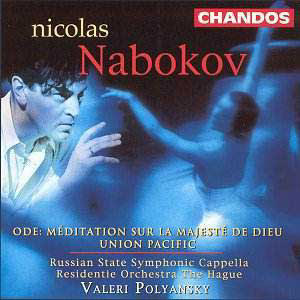‘He really has a gift that I find pleasant’ smacks
a little of being damned with faint praise, but coming from Stravinsky
in 1929, one supposes that the 26 year-old composer Nicolas Nabokov
took it at face value and basked in the glory.
The name Nabokov is unknown in the music world today,
at least comparatively less so than in the world of literature thanks
to his cousin Vladimir who wrote the novel Lolita. Nicolas was
born into Russian gentry and so fled Russia in 1919 for good, studying
with Busoni in Berlin, and then in 1923 he went to Paris to join all
those Russian émigrés who polarised around Diaghilev and
his Ballets Russes, hence the encounter with Stravinsky. The result
of his acceptance into the circle was his first major work, the ballet-oratorio
Ode, composed and scored between 1925 and 1928, and performed
for the first time in 1928 to choreography by Massine, one of Diaghilev’s
last successes before his death a year later. The music’s style is quintessentially
Russian, from Rimsky-Korsakov to Stravinsky, shades of Orff’s Carmina
Burana and Shostakovich in places (which of course it pre-dates
in both cases), but perhaps more of Prokofiev’s influence than anyone
else’s. In effect the work is more of a choral work than a ballet, not
like Stravinsky’s Symphony of Psalms but more like a Glinka opera.
The choral writing is very homophonic, rather than polyphonic or contrapuntal,
the text being based on the 18th century poet and scientist
Mikhail Lomonosov (1711-1765), ten loosely related movements consisting
of airs, recitatives, duos, choruses and symphonic interludes. It is
very attractive music largely due to its diversity of styles, sometimes
hovering between pastiche and truly original, if occasionally banal.
Union Pacific, another ballet score and dating from 1934, could
have been penned by Shostakovich, Kurt Weill or Bernstein, or furthermore
been the score for a film. It depicts the construction of the famous
Union Pacific railroad and was inspired by old cylinder recordings of
popular songs and dances from the early 1900s.
The performances by the Dutch Residentie Orchestra,
the Russian chorus and two soloists, are full of vitality under Polyansky,
the scores delivered with colourful panache and style, Nabokov’s scoring,
in particular of Union Pacific, being the strength of his inventiveness.
Interesting, and above all, enjoyable music.
Christopher Fifield


